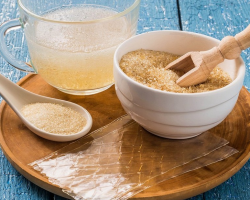Mastitis in the dog is as painful as in humans. Let's figure out the causes and methods of treatment.
Content
For a female, any animal that feeds its cubs with milk, there is always a danger of sick mastitis. This ailment consists in inflammation of the mammary glands, which is terrible of its consequences - up to death.
We suggest you get acquainted with the causes that provoke the occurrence of mastitis in dogs, and the most effective therapeutic techniques so that your pet is always healthy.
Why does mastitis appear in a dog?
Usually, mastitis in the dog It occurs as a result of pathogenic microorganisms in the mammary glands - staphylococci and streptococci, clostridia and E. coli (through injured skin or directly through the nipple channel opened during feeding).
Mastitis becomes purulent when microorganisms that contribute to decay enter the body of the animal.

According to experts, nursing bitches with the following characteristics are at risk:
- With an excess of milk, which bears the scientific name “lactostasis” (the milky paths are squeezed, the iron swells and hardens, and the bacteria begin to actively develop for their pleasure, leading to inflammation).
- All kinds of mechanical damage to the skin (combs, cuts and the like relieves all protective barriers from the dog body, allowing evil microbes to freely penetrate inside).
- The blocked milky paths (the causes of this phenomenon can be different, but mastitis will certainly become the result).
- Strong hypothermia or overheating (weakens the body of a nursing bitch, which is more difficult to fight with the attacks of pathogenic microorganisms).
- Pseudo-embroidery (a fairly common state of bitches, as a result of which milk begins to be produced in the mammary glands, which is stagnated in the same place).

- A genetic tendency to disease (owners of bitches with such genetics are best sterilized immediately so as not to experience fate).
- A sharp and untimely interruption of lactation (it happens that puppies are too early or very sharply taken away from the female, which can lead to lactostasis).
- Infection of the body (if the nursing bitch suffers from any infectious disease, then the appearance of mastitis may be the result).
- Intoxication (poisoning will reduce the dog’s immunity, which can cause inflammation of the mammary glands).
Types of mastitis in dogs?
In fact, there are various types mastitis in the dog, which only a qualified veterinarian can diagnose correctly. Moreover: some varieties of the disease are very difficult to notice with an unprofessional look, and your pythomitsa will not be able to “tell you about it in time.
Therefore, you need to carefully monitor the nursing bitch: how it behaves during feeding the kids, does it show anxiety, does it have damage in the mammary glands in what condition they are. If you suddenly suspected something was wrong, then immediately consult a veterinarian, who will prescribe adequate treatment. Like many other diseases, mastitis can occur in acute or chronic form.

In addition, the following types of this disease are distinguished:
- Catarrhal (extremely difficult to determine “by eye”; differs in the simultaneous secretion of secretion and mucus; without timely treatment, the dog’s condition will be systematically deteriorated).
- Serous (characterized by the release of exudate during lactation; symptoms are quite bright, but accurate diagnosis is possible only on the basis of test results).
- Fibrinous (differs in that dense white - the so -called fibrin threads appear from the nipple).
- Purulent (as the name itself is clear, when lactation in a sick bitch in milk, pieces or threaded purulent strips appear - white or yellowish, which leads to the appearance of a characteristic smell and even a change in the appearance of the milk itself. It is necessary to immediately excommunicate the cubs from feeding and turn to a specialist !).

- Phlegmonous (dangerous in that purulent discharge is not at first shown in milk, but pouring subcutaneously; if you do not take measures in time, that it will turn into purulent).
- The abscessing (not too common type of mastitis, causing an abscess on the mammary gland).
- Gangrenous (causing decomposition of breast tissues - is considered the most dangerous).
How to find mastitis in a dog?
Experienced dog owners know that the health of their pets needs to be constantly monitored (because they cannot complain about light ailments), but not only their life, but also the health of the kids depends on this. And the faster to identify the problem, the easier it will be to eliminate it with the least consequences.
Make out mastitis in the dog It is quite difficult, especially since it often “masks” under lactostasis. But most often, in the presence of mastitis, the nursing female becomes sluggish, drowsiness and apathy appear, appetite and generally interest in food are reduced, and the temperature gradually rises.

During a visual examination, it is not difficult to determine the iron affected by mastitis: it increases, becomes hot, reddened and edematous, hardens. In addition, pain occurs on palpation, so the animal will avoid your touch, lick this place, and whit up.
If you slightly squeeze the nipple, then you will see the discharge - white, pus or blood, perhaps - you will feel an unpleasant odor.
Dog mastitis treatment?
If you suspected mastitis by his dog Turn to a specialist immediately, because this is not a disease that can be easily diagnosed and cured at home.
For a successful fight against pathogenic microorganisms, you will need antibiotics, the appearance of which will be prescribed by a veterinarian. After all, general spectrum drugs do not always help, so sometimes you have to prescribe treatment based on tests.
You can only alleviate the condition of the dog as follows:
- Warming up the injured breast using camphor oil (exclusively with a catarrhal or serous variety of mastitis).
- Lightly expressing milk with the subsequent imposition of a tight dressing (the resulting sample is best handed over to the research laboratory).
- Strengthening immunity using special drugs (modulators and stimulants).

In addition to antibiotics, veterinarians are usually prescribed vitamins, as well as means to lower temperature and removing pain, with pseudo-gain, preparations for interruption of lactation will also be required. In very advanced cases, surgery with breast removal may be required.
Prevention of mastitis in a dog?
- For the prevention of the disease, it is necessary to conduct timely examinations with the veterinarian, and if you do not plan a viscous, then the best is the best to sterilize the dog.
- Try to equip the dog’s place of residence so that it is warm and clean, it does not through.
- If you find injuries and abrasions in the area of \u200b\u200bthe mammary glands, then do disinfection. So that the kids do not scratch their mommy, they can cut the claws two weeks after birth.

In the case when lactation is not carried out (pseudo-embroidery or death of babies), a tight bandage should be applied to the mammary glands to stop the release of milk.







